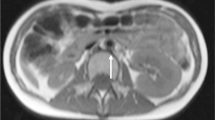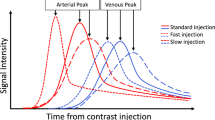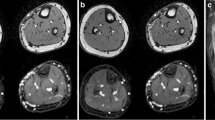Abstract
Non-invasive imaging of cardiovascular disease in pediatric subjects has been an elusive and much anticipated development for many years. Magnetic resonance angiography (MRA) has now been established in many institutions as an important diagnostic method for evaluating vascular disease in adults. However, MRA techniques have disseminated more slowly in children owing to significant technical challenges in the pediatric population, including motion, low signal-to-noise ratio, and suboptimal temporal or spatial resolution. Recent technical developments in MRA have addressed many of these issues, and the MRA acquisition methods are far more robust than previously used techniques. The objective of this manuscript is to discuss the indications for MR imaging, the techniques employed, and the imaging findings expected on MRA of children with vascular disease.

















Similar content being viewed by others
References
Techniques and indications pediatric MRI monograph. In: ACR (ed) ACR practice guidelines and technical standards, pp 745–750
Wehril F (1986) Time-of-flight MR flowing imaging: selective saturation recovery with gradient refocusing. Radiology 160:781–785
Keller P, Drayer B, Fran E (1989) MR angiography via 2D acquisition but yielding a 3D display: a work in progress. Radiology 173:527–532
Dumoulin C, Yucel EK, Vock P (1990) Two and three dimensional phase contrast MR angiography of the abdomen. JCAT 14:779–784
Prince M, Yucel EK, Kaufman JA, et al (1993) Dynamic gadolinium-enhanced three-dimensional abdominal MR arteriography. J Magn Reson Imaging 3:877–881
Prince M (1994) Gadolinium-enhanced MR aortography. Radiology 191:155–164
Konen E, Merchant N, Provost Y, et al (2004) Coarctation of the aorta before and after correction: The role of cardiovascular MRI. AJR 182:1333–1339
Connolly HM, Huston J 3rd, Brown RD Jr, et al (2003) Intracranial aneurysms in patients with coarctation of the aorta: a prospective magnetic resonance angiographic study of 100 patients. Mayo Clin Proc 78:1491–1499
Araoz P, Reddy GP, Tarnoff H, et al (2003) MR findings of collateral circulation are more accurate measures of hemodynamic significance than arm-leg blood pressure gradient after repair of coarctation of the aorta. J Magn Reson Imaging 17:177–183
Mustert B, Williams DM, Prince MR (1998) In vitro model of arterial stenosis: correlation of MR signal dephasing and trans-stenotic pressure gradients. Magn Reson Imaging 16:301–310
Nastri MV, Baptista LP, Baroni RH, et al (2004) Gadolinium-enhanced three-dimensional MR angiography of Takayasu arteritis. Radiographics 24:773–786
Muthupillai R, Vick GW 3rd, Flamm SD, et al (2003) Time-resolved contrast-enhanced magnetic resonance angiography in pediatric patients using sensitivity encoding. J Magn Reson Imaging 17:559–564
Carroll T, Grist TM (2002) Technical developments in MR angiography, In: Hagspiel K, Matsumoto A (eds) Radiologic clinics of North America—vascular imaging. Saunders, Philadelphia, pp 921–951
Greil GF, Powell AJ, Gildein HP, et al (2002) Gadolinium-enhanced three-dimensional magnetic resonance angiography of pulmonary and systemic venous anomalies. J Am Coll Cardiol 39:335–341
Valsangiacoma ER, Levasseur S, McCrindle BW, et al (2003) Contrast-enhanced MR angiography of pulmonary venous abnormalities in children. Pediatr Radiol 33:92–98
Rees RS, Sommerville J, Underwood SR, et al (1987) Magnetic resonance imaging of the pulmonary arteries and their systemic connections in pulmonary atresia: comparison with angiographic and surgical findings. Br Heart J 58:621–626
Schoenberg SO, Knopp MV, Bock M, et al (1997) Renal artery stenosis: grading of hemodynamic changes with cine phase-contrast MR blood flow measurements. Radiology 203:45–53
Korosec FR, Frayne R, Grist TM, et al (1996) Time-resolved contrast-enhanced 3D MR angiography. Magn Reson Med 36:345–351
Herborn CU, Goyen M, Lauenstein TC, Debatin JF, et al (2003) Comprehensive time-resolved MRI of peripheral vascular malformations. AJR 181:729–735
Sodickson DK, Manning WJ (1997) Simultaneous acquisition of spatial harmonics (SMASH): fast imaging with radiofrequency coil arrays. Magn Reson Med 38:591–603
Block WF, Grist TM, Mistretta CA (2001) In: Time-resolved vastly-undersampled isotropic projection (VIPR) imaging with spatial frequency dependent temporal filtering. XIII Annual International Workshop on MR Angiography, Madison
Grist TM, Korosec FR, Peters DC, et al (1998) Steady-state and dynamic MR angiography with MS-325: Initial experience in humans. Radiology 207:539–544
Acknowledgements
The authors thank Judy Imhoff for manuscript preparation.
Author information
Authors and Affiliations
Corresponding author
Rights and permissions
About this article
Cite this article
Grist, T.M., Thornton, F.J. Magnetic resonance angiography in children: technique, indications, and imaging findings. Pediatr Radiol 35, 26–39 (2005). https://doi.org/10.1007/s00247-004-1350-1
Received:
Accepted:
Published:
Issue Date:
DOI: https://doi.org/10.1007/s00247-004-1350-1




